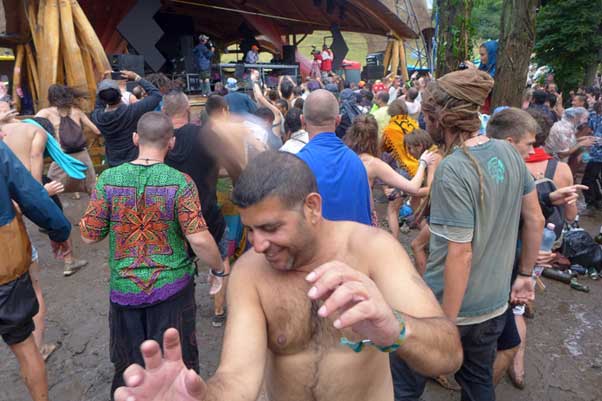
Alan Dearling

Music has been a major part of my life since the 1960s. It continued to be a part of my lifeblood from my school days on the south coast of England, through my time as a university student (and sometime scribe and promoter) at the University of Kent at Canterbury (UKC) from 1969, during what became known as the ‘Canterbury Scene’. Members of bands like Caravan and Spirogyra, along with Steve Hillage were actually some of my fellow students there. But the legacy of Soft Machine, Daevid Allen and Kevin Ayers lived on. Outsider Music, so-called ‘Alternative Music’ before the term ‘Indie’ was invented. And alongside performers at the UKC – mainstream bands such as The Who, Led Zeppelin, the original Fleetwood Mac and Chicken Shack, many of the students had their own favourites such as Quintessence and the early line-ups of Hawkwind and Family. Not only were these bands dubbed ‘psychedelic’, so too were the drugs consumed by many of the audience at gigs and those early festies such as Phun City, Harmony Farm and the Isle of Wight extravaganzas! The very word ‘psychedelia’ summons up images of hallucinations, ‘trips’ and mind-altering experiences. And it could be argued that in their own way, Raja Ram with Quintessence were amongst the earliest purveyors of ‘psy-trance’, with Indian rhythms and chants combined with the smells of joss sticks and incense. ‘Blissful Company’ was the very appropriate title of their first album in 1969. Raja Ram (actually Ron Rothfield originally from Australia) contributed to my co-authored book with Mook Bahloo, Alternative Australia – and by that time in about 2000 was one of the leading light DJs of the post-Goa techno-tribes, forming Shpongle with Simon Posford. I last saw him wowing the crowd, in a deluge of rain and mud at the Ozora Festival in Hungary in 2019 (first pic and below). I also spent time watching and chatting with Gaudi and Youth at Ozora and Steve Hillage and Miquette Giraudy (pics below).

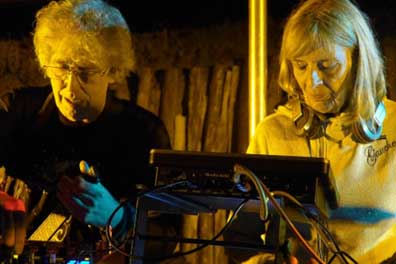
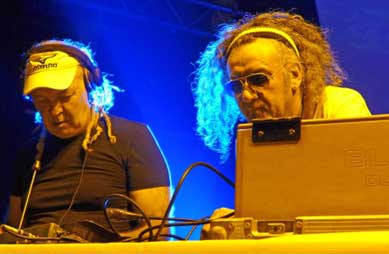
But back in the student days of my youth, I was privileged to experience many aural and visual adventures in the presence of Hawkwind, loud and insistent, repetitive, sonic, emitting wave upon wave of mind-frying psychedelic beats. Hypnotic early light shows featuring liquid wheels, background film projections of scenes from movies such as Bunuel and Dali’s ‘Un Chien Andalou’, powerful strobes, oscillators, minimoogs and even theremin and keys (courtesy, over the Hawkwind-years, of a diverse range of musicians including DikMik, Del Dettmar and Tim Blake). These were a major element in the musical Warp factor. It was drum and bass-driven, with Terry Ollis, the legendary naked Hawkwind drummer and dancer, Stacia Blake, providing added ingredients for ‘turning on’ and ‘freaking out’. As Mojo magazine’s Ian Harrison recalled in issue 312 in late 2019, it was a story of: “…serendipity, LSD, speed, strobes, nudity, idealism and chances taken and squandered.” Entering into the ‘Space Ritual’ was one of the rites of passage. Space Rock had arrived by the beginning of the 1970s. Canterbury was one of its geographic focal points. But, of course, we didn’t know that the Canterbury Scene was happening. Sensory overload was an essential part of the experience. You just lived it. Scarred, possibly for life, but maybe in a good way! The repetitive beats that were the foundation of the Hawkwind sound spawned many other offshoot bands and probably fuelled the nascent electronic dance music phenomenon that gradually evolved from the 1970s onwards.
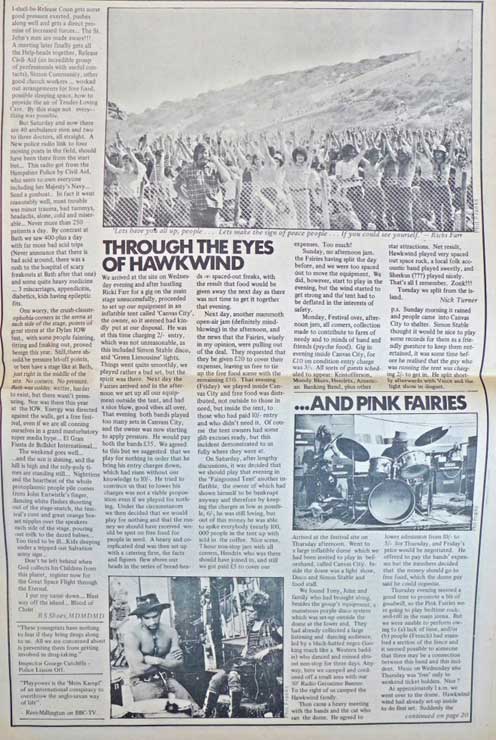
From 1972, I was a full-time youth worker in clubs in Essex, London and Scotland, with a budget for putting on many bands and performers. It enabled me to support many young people at the clubs that I ostensibly ran to participate in music as performers as well as spectators. I was a sometime writer, contributing to some of the early underground magazines and student magazines, and gradually evolved as a photographer. I wrote literally many hundreds of articles for the youth work, social work and mainstream press about young people, places and events – many linked to music events, bands, the politics of youth and countercultures. From 1979 onwards I wrote, commissioned and edited books, full-time from about 1988. Again, these books often featured music centre-stage. Remembering back to the ’60s onwards, pop, rock, blues, prog (progressive)
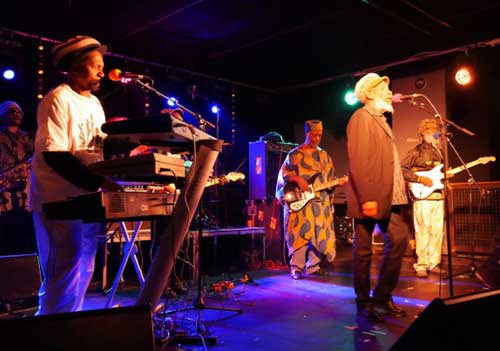
and underground and experimental music spread its many tentacles into jazz, free form, reggae and later, punk and new wave. Disco, glam, pop, metal, rave, techno and fusions. Dance was never my passion, but over the years my involvement and understanding grew through my proactive involvement in the Reggae Sound System clashes, featuring MCs, bands like Misty in Roots (in photo). Reggae has always provided the rhythm and beats for dance. I became a ‘regular’ at many Travellers’ festivals and events with their travelling sound systems, visiting Goa’s Calangute and Candolim, and much later at forest raves (‘doofs’) in New South Wales and Queensland, Australia. And I was subsumed into the relatively anarchic dance music of the late 1980s and into the ’90s at Glastonbury, with the likes of Zion Train playing alongside DJs, The Orb and Prodigy. The Orb’s first two albums caught the electronic hearts and minds of a generation – The Orb’s ‘Adventures beyond the Ultraworld’ (1991) and ‘U.F.Orb’ (1992). The original Orb split in two, with Alex Paterson continuing at the helm of various iterations of The Orb, whilst Jimmy Cauty became one half of the hugely influential JAMS or JAMMS (the Justified and Ancients of Mu-Mu) and the mighty, genre-defying,
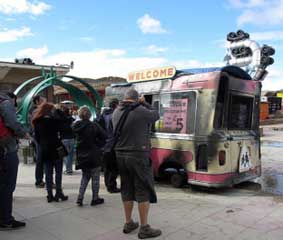

KLF in their ice-cream van (which I believe stands for the Kopyright Liberation Front). ‘TranCentral’, ‘Justified And Ancient’ and ‘What Time Is Love?’ had become signature sounds in the 1990s’ worlds of clubbers, trancers and party people. Cross-cultural interests took my travelling soul to seek out ‘free cultural spaces’ such as Ruigoord outside Amsterdam, Christiania in Copenhagen
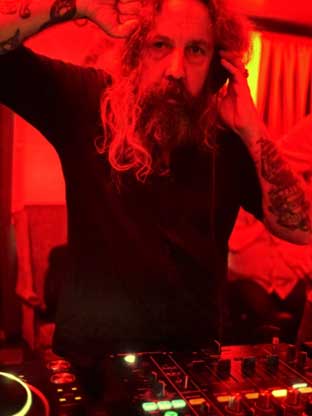
(Landjuweel photo), and trips into African music – that is essentially dance music and on the edges of psychedelia from the likes of Sunny Ade and Fela Kuti. Whilst festies like Boom in Portugal (pic on next page), Ozora in Hungary, and events in Uzupis in Lithuania are mostly DJ-oriented, I’ve been enjoying a creative mix of live and DJ-oriented events around Todmorden in West Yorkshire. These have included electronic and psychedelic sets from DJs/producers such as Andy Votel, David Holmes, Andrew Weatherall (photo left), cross-cultural ambassador of techno-punk and much else (before his untimely demise), Goldie, A Guy called Gerald (808 State) and The Orb. And even the snooker supremo, Steve Davis, who currently teams up with Kavus Torabi (front-man from the new incarnation of Gong), and are two-thirds of The Utopia Strong. Taken together, these gigs, these musicians have taken me into the Freak-Zones of popular music and beyond. I realise now that I have actually become much more involved with Electronic Dance Music (EDM) than I thought. Even, if I’m essentially an Old Hippy!
Delving back to the past…
I was never passive in my musical and cultural obsessions. I made very real efforts to attend gigs and festivals, and went travelling to Amsterdam in the late 1960s and was able to drift in and out of the squatting, arts scene and the clubs like Paradiso and Melk Weg (the Milky Way). There, I met pioneers of the ‘underground’ and the Provos (the Provocateurs), the Gnomes and the members of the Amsterdam Balloon Company who became the first kraakers and took over the free cultural space at Ruigoord. I was at the magnificent mess and madness that were the Isle of Wight festies of 1969 and 1970. The psychedelic music from the 1960s onwards was essentially a mixed palette of styles, instruments and sounds. Electronica was a part, but so were the whimsical psychedelic sounds, sometimes called ‘Acid-folk’, created by the likes of the Incredible String Band, Dr Strangely Strange and Donovan. Psychedelia was a many-headed Hydra. Still is! The Small Faces’ ‘Itchycoo Park’, with its phased instrumentation, was sometimes lumped together with the music of other so-called ‘experimental’ bands like Pink Floyd (who I saw live with Syd Barrett at the Shoreline Club in 1967 on the seafront at Bognor Regis in West Sussex). This was way back when they were performing their hit single, ‘See Emily Play’, along with extraordinary space-electronica such as ‘Astronomy Domine’, with synths played by Roger Waters and Richard Wright and later keyboards and synthesisers by David Gilmour. They were just entering one of their most improvisational/experimental stages. The Beatles’ own experiments in sound demonstrated the effectiveness of electronics with collisions of eastern and western sounds in tracks like ‘Tomorrow Never Knows’, ‘Lucy In Sky With Diamonds’ and ‘Baby You’re A Rich Man’ and the cacophonous ‘Revolution Number 9’. The UK’s underground press, particularly International Times and Oz, serviced the music and festi scene advertising gigs, reporting on others and promoting the gurus of the day such as William Burroughs, Allen Ginsberg, Timothy Leary, Ken Kesey and a little later, Hunter S. Thompson. I was a tiny part of that ‘revolution in the minds’ of a generation.
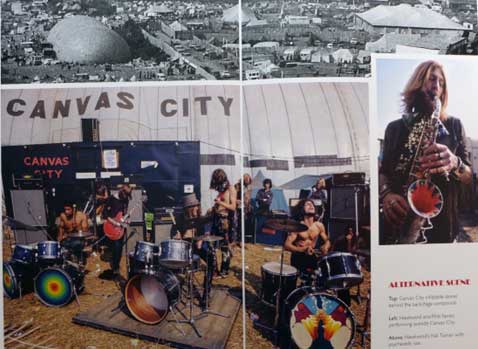
If Hair was the first major hippy musical on the West End stage in the 1960s, the crashing organ and Moog sounds of Keith Emerson of The Nice (and then with Emerson, Lake and Palmer) provided another mythic musical symbol. I’d put them into the same experimental musical category as the dark swirling sounds of Brian Auger’s organ coupled with the rather spiky and ethereal voice of Julie Driscoll on their version of Dylan’s ‘This Wheel’s on Fire’. I was much impressed with the live power and energy, if not always the over-the-top showmanship of Mister Emerson. ELP were one of the headline acts at the Isle of Wight festival on their debut gig.
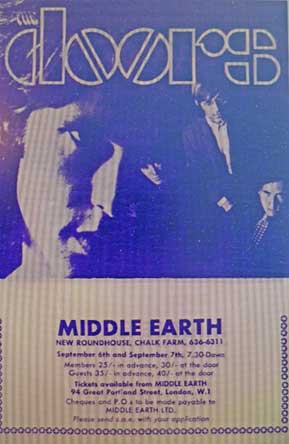
Likewise, the two-handed mix of piano-bass and electric organ sounds of Ray Manzarek on The Doors’ tracks, ‘Light My Fire’, ‘When the Music’s Over’ and ‘The End were soundscapes for the anti-Vietnam protests, along with some of the music by Jefferson Airplane, Grateful Dead and Crosby, Stills, Nash and Young, and even Frank Zappa and compatriots. Dance music it wasn’t. But psychedelic and drugs-induced, Yes! ‘Eight Miles High’ indeed…
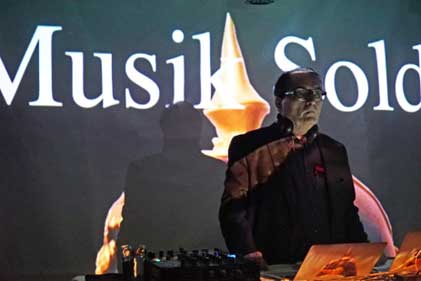
An out and out favourite electronica album from my student days was the ground-breaking, ‘An Electric Storm’ from White Noise. David Vorhaus formed this outfit with Delia Derbyshire, a member of the innovative, BBC’s Radiophonic Workshop. It wasn’t a happy musical relationship. Yet, it still holds up today as being a heady mix of the psychedelic, the experimental and the unsettling. Delia is now oft-referred to as the creator of the Dr Who theme, but to my mind ‘Electric Storm’ really is a mini-masterpiece! The invention of the Moog synthesiser by Robert Moog in the USA (essentially a pitch-alternating oscillator) fuelled many cross-over experiments between electronic and classical music. These included the musical soundtrack recorded in 1971 by Wendy Carlos for the Stanley Kubrick film, Clockwork Orange, which was apparently the first record to make use of a vocoder. Later in 1973, Isao Tomita transformed Debussy’s music into the electronic ‘Snowflakes Are Dancing’, with the Moog ‘sound’ at its heart. Other electronic ambient pioneers who were sometimes perceived as outliers in psychedelia included Neil Ardley, pianist and synthesiser player (‘Kaleidoscope of Rainbows’) and Terry Riley, using tape loops and synths (‘Rainbow in Curved Air’ and ‘In C’) – both perhaps viewed as jazzers. Then there was Tangerine Dream, who I witnessed when working back stage at the Chichester Festival Theatre in 1974. The stage was completely dominated by a vast Moog. Their set was relatively early into their career (though they had actually formed in Germany in 1967), and Edgar Froese was busy working on his solo Aqua album. Tangerine Dream were named apparently through a mis-hearing of the line about “Tangerine trees” in the Beatles’ ‘Lucy in the Sky With Diamonds’. They were definitely forerunners of psychedelic prog electronica conjuring up panoramic, sweeping soundscapes, way before the pomp and sometimes overblown outputs of the Greek, Vangelis, and from France, Jean Michel Jarre with ‘Oxygene’, which is a sort of ‘Tubular Bells’ for synths. Before and after came Kraftwerk, formed in 1970, but whose career went luminescent from 1974, with ‘Autobahn’. They were the architects of Krautrock, along with Can and Neu! Kraftwerk can be viewed as the masters of machine-music and even techno. I recently took photos at a solo set from Wolfgang Flur (pictured), who was the electronic percussion player in Kraftwerk during their most commercially successful period.
Then there’s possibly the most influential of all in the evolution of electronica in popular music, Brian Eno, who started out in 1971 with Roxy Music, using a VCS 3 synthesiser, but later became revered as an ambient electronic pioneering composer and performer. Brian Eno is also a highly influential producer and worked collaboratively with David Bowie on his Berlin trilogy – albums that took Bowie into new sounds and new musical territories. ‘Low’, ‘Heroes’ and ‘Lodger’ were ground-breaking, weird and wonderful, exhilarating in equal parts. Electronica through its use of instrumental textures had arrived in the darker recesses of the musical mainstream. ‘Speed of Life’ was a prescient title for the opening track on ‘Low’.

The new Traveller festivals in the UK spawned new sounds, bands and sound systems. And it intertwined with the party scene, garage and squat events. Collectively this somewhat anarchic DiY spirit spilled into the dance tents of Glastonbury and other major events and gradually festival organisers came to the realisation that the true performers at many musical events were the punters – the crazy dancers. They were also using a different range of drugs like ecstasy and ketamine. For some, the party seemed to never stop. From these pioneers, music – much of it electronica, with many ‘world’ influences, and certainly dance-orientated – emerged from Dubzone, Ozric Tentacles Trans-Global Underground, Inner City Unit, Astralasia, Underworld, Alien Progeny, Leftfield, Massive Attack, Chemical Brothers, Hallucinogen (a Simon Posford project) and Merv Peplar (pic, performing as Eat Static). There were many others too who fed into the music sets from DJ outfits like Spiral Tribe, Bedlam, the Exodus Collective and more mainstream DJs such as Fat Boy Slim, Billy Nasty and Andrew Weatherall. It’s quite a list!
Musical ‘boundaries’ were increasingly blurred, club and house, techno and trance music melded with dub, reggae, world sounds and even Old Skool blues, two-tone, blues, ska and rockabilly. Early reggae MCs became rap stars. But electronic beats, drum ‘n’ bass were increasingly programmed by DJs to segue beats from one track and musical sequence into the next to keep the dance-floors across Europe and the world – pumping! But, there was also a softer side of chill-out sessions, a rise of ambient trance. Still forms of electronica, but of different hues. French creators, such as Air, Daft Punk and even the music of Serge Gainsbourg, have been re-mixed by the like of The Orb and Howie B, adding in their musical spices and herbs to the concoctions. Spiritualised, Portishead, Kosheen and Orbital were significant players too. But there are many, many more.
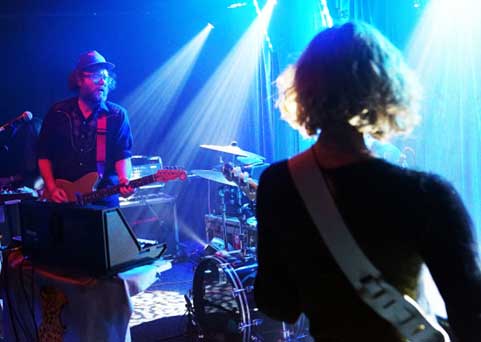
Luckily, new outfits and conglomerations of artists will always be emerging. For instance, very recently I’ve enjoyed a thoroughly invigorating set from Aircooled (photo), who are largely members of Placebo, the Wedding Present and Neotropic. Aircooled is an exciting new band mixing vocals, instruments and electronica into a newly crafted tapestry of sound. Nu-jazz is also a seed bed for cross-pollination of musical ideas and styles, with the likes of the Ezra Collective and Plant Food using many elements of electronica, EDM and psychedelia and mixing it up in bubbling creations of rap, jazz, soul, rock and more. Another unusual artist in electronica who I saw recently at the Hope Chapel in Hebden Bridge, West Yorkshire is Dave Clarkson. After the gig, I bought his solo album, ‘A Pocket Guide To Dream Land (Faded Fairgrounds And Coastal Ghost Towns)’, which features field recordings of rollercoasters, penny arcades, spectral ballrooms, steam organs and much more sampled from across the UK which Dave has, he said, “complemented, mangled or untangled”. It’s definitely electronica, full of loops and strangely hypnotic, but it ain’t EDM!
Summing up (sort of)
I’ve been privileged and lucky to make time to see many of these performers as I travelled in the UK, in Europe and beyond, to festies such as Woodford in Queensland, Australia, events at the squatted ADM outside of Amsterdam and Landjuweel at Ruigoord nearby, often bumping into musical friends such as Gaudi, Youth, Chris Tofu (and Continental Drifts’ artists at the ‘London Re-Mixed’ festivals in Shoreditch, London). Then there’s Eat Static and Steve Hillage, performing DJ sets with Miquette Giraudy as System 7 and Mirror System, and in particular the extended families of Gong, Zion Train, Hawkwind and Nik Turner (and his many collaborators) to name just a few.
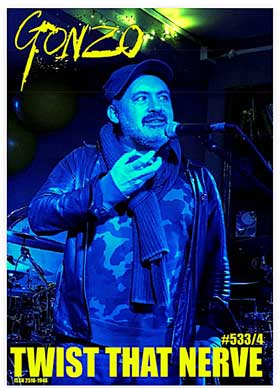
In the late ’70s, the 1980s and well into the ’90s, I was writing and editing a lot of books, increasingly many with, and about, the new Traveller and eco-protest scene and their festivals in the UK and Europe. I lived on a narrowboat for a while on the River Severn and around the ‘Cut’ as the canal system was known by boaters. I was attending relatively few mainstream gigs and wasn’t in the Manchester and Factory Records orbit at all. I’ve become much more aware of it since moving to a new home in Todmorden in West Yorkshire, where the Mad-chester scene still holds much sway. So, whilst I bought a few of the records that were electronica and then rave – it wasn’t much on my personal radar. More so now on the outer fringes of the diverse worlds of Joy Division, New Order, who brought a Goth-darkness and dance ethos into post-punk electronica, and the more energetic Happy Mondays, the Stone Roses, and Primal Scream who originated in Glasgow but later worked with Andrew Weatherall, Alan McGee from Creation Records, and Youth. I only saw glimpses of these bands at festies such as Glasto. It was not a major feature of my life, though the latter three bands could be said to blend psychedelia and rock together with dance beats and ‘mixes’, they were not particularly part of electronica. I think though, that I was fairly aware of the move away from old-style psychedelia, to much more dance-focused sound systems and events. In and around Todmorden, I am taking more photos, writing articles and reviewing some of those bands and even more DJs who were major players in the Mad-chester days of Acid House and famed, Hacienda Club, including working at the Twisted Nerve Records 25 year party event in December 2022 hosted by Damon Gough (Badly Drawn Boy) and Andy Votel.
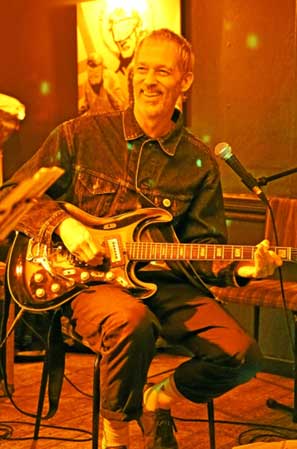
Andrew Weatherall was last at the Golden Lion in Todmorden with his many worldwide and local fans and friends for the 5th ALFOS weekender (A Love From Outer Space) with Sean Johnston and others, in June 2019. Sadly, it took place only a relatively short time before his untimely demise at the age of 57 in February 2020. I was there for most of that weekend, and had opportunities to chat with him, finding him to be gentle, warm, companionable and deeply knowledgeable concerning many styles of music. The range of music he played over three days was genuinely genre-defying. It encompassed rockabilly, blues, psychedelia, techno, electronica, rave, hip-hop, rock and dance. But I guess, Andrew will be most remembered for being centre-stage during Acid House and as the producer of Primal Scream’s ‘Loaded’ from ‘Screamadelica’ and My Bloody Valentine’s ‘Soon’. His own electronica trio, The Sabres of Paradise, released three cult albums and others with Chris Mackin in Two Lone Horseman. Recently I was invited to the AW60 weekender to take photos of the event – a celebration of Andrew’s life, along with many members of his family and DJ and musician friends, including Andy Bell (in pic above) (Ride, Oasis, GLOK and solo electronica). I’ve also been able to watch GLOK – an amazing and innovative electronica extravaganza. All in all, the magnificent parties continue for AW, the Guv’nor!

I like to explore and push my own musical boundaries too and delve into the cracks and crannies of music. I really rather abhor ‘labels’ and categorisations of musical genres. But even before my visits to WOMAD events and the World stages at Glasto and beyond, I guess I was a proponent of music that was ‘Jeux sans frontieres’! The divisions between producers, composers, performers, musicians, DJs, MCs had been warped and twisted into new alien musical life-forms many years earlier. Re-mixes, musical exhumations, recycled… New and Old Skools. And, whether a music set is ‘Banging’ or ‘Cool – the Beats do just ‘go on’!
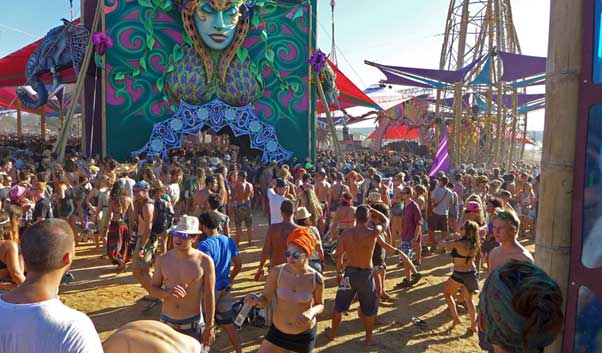

This reads like like the synopsis for a great book.
Comment by Neil Houlton on 27 November, 2023 at 9:46 am